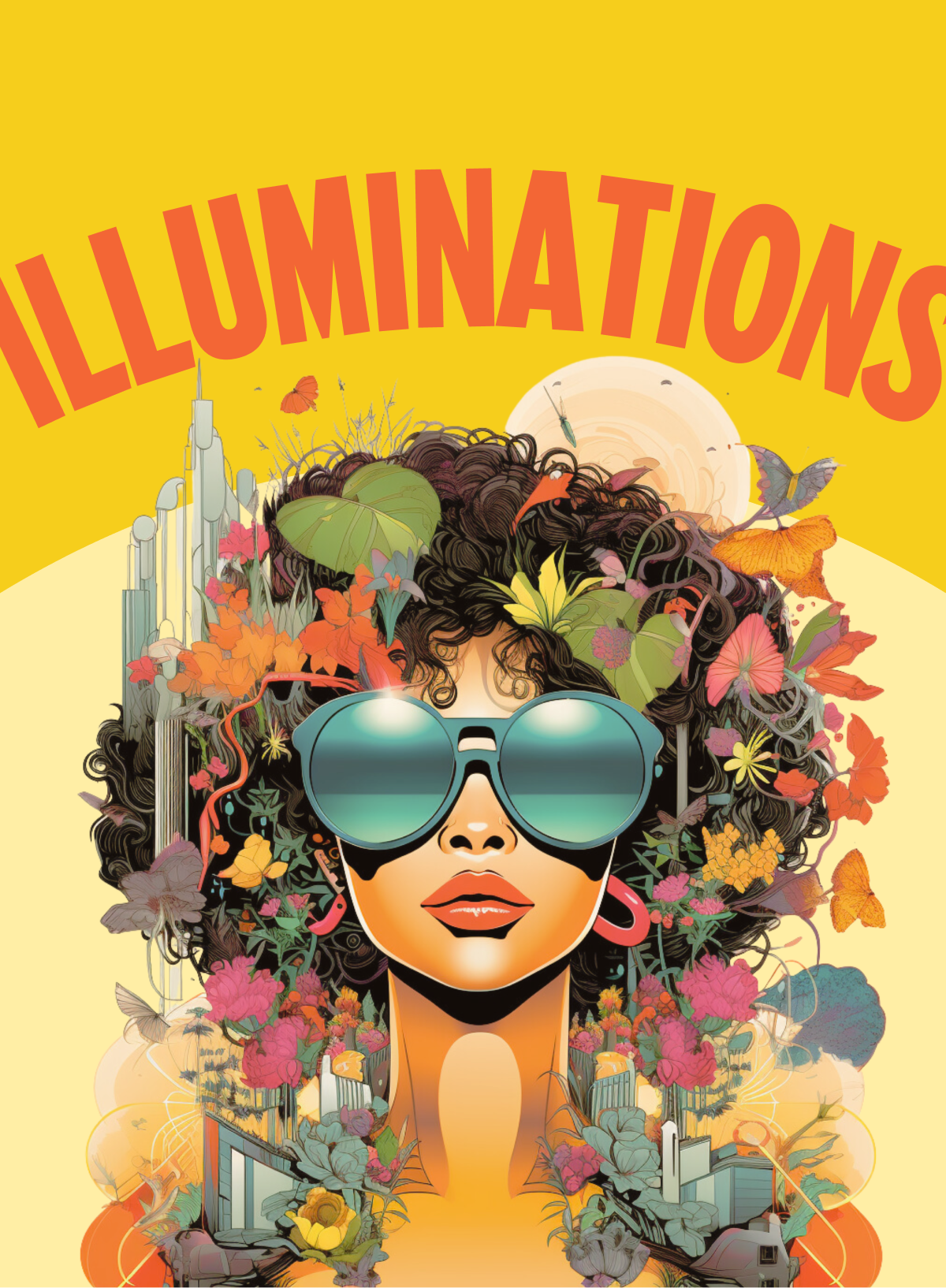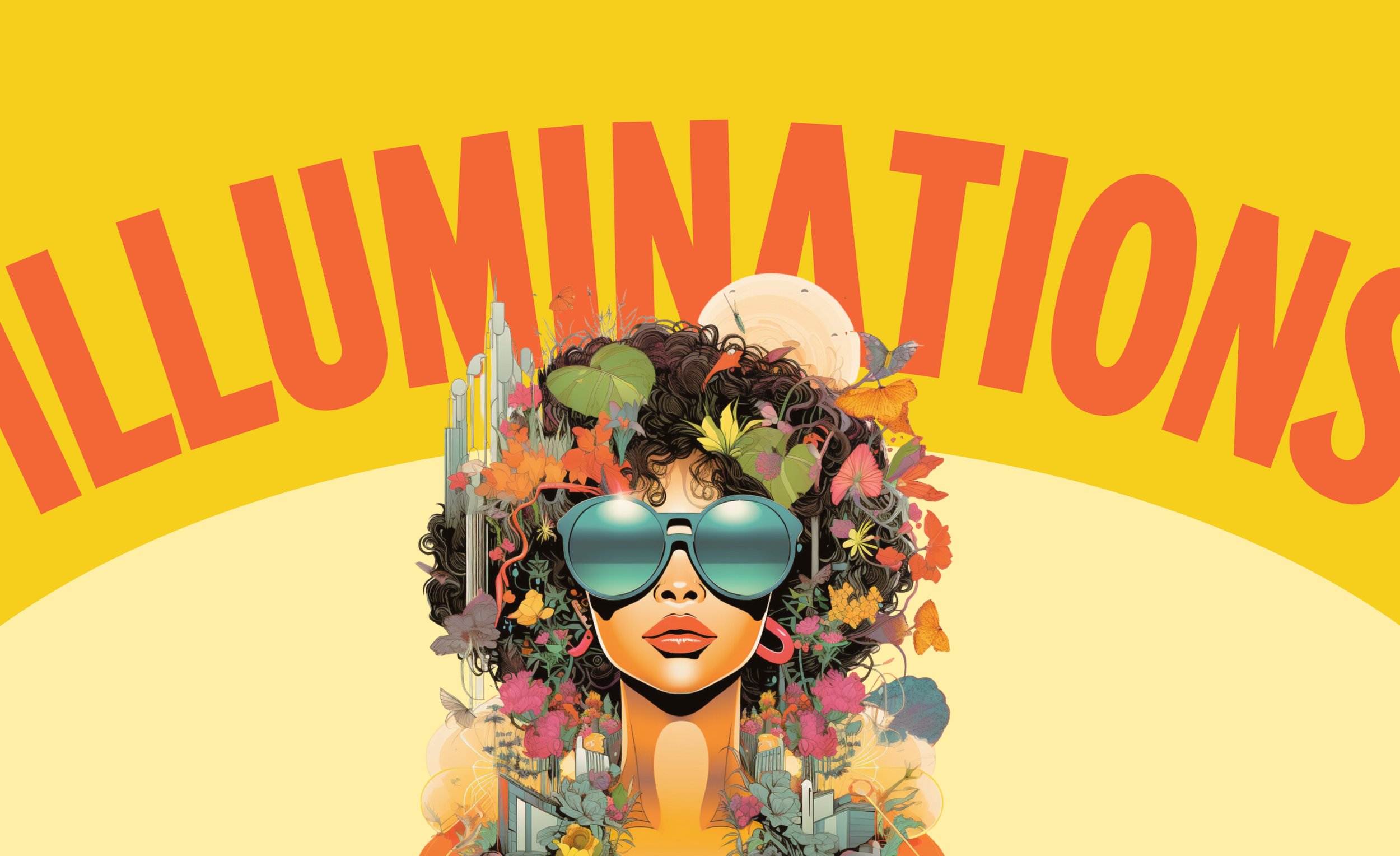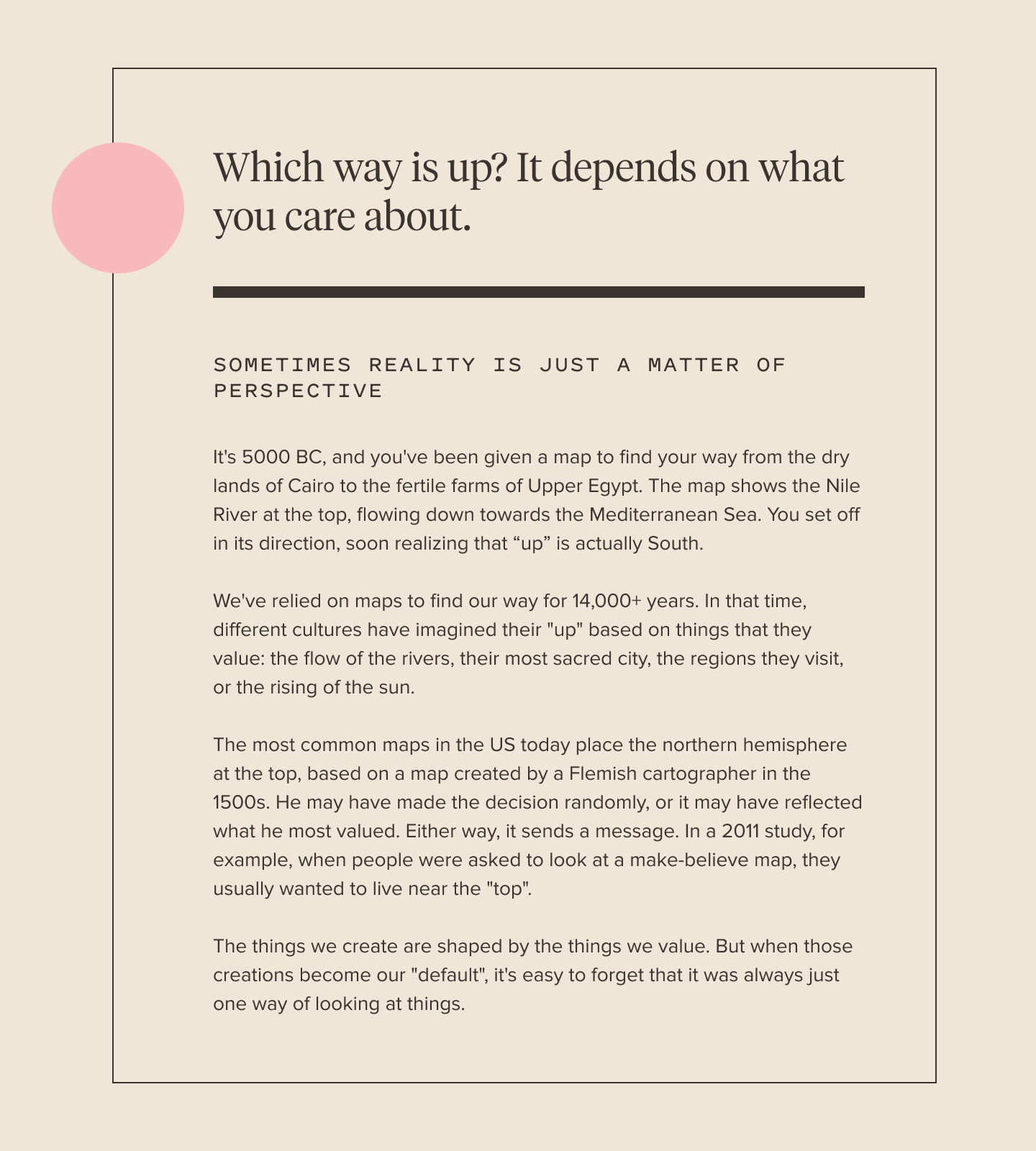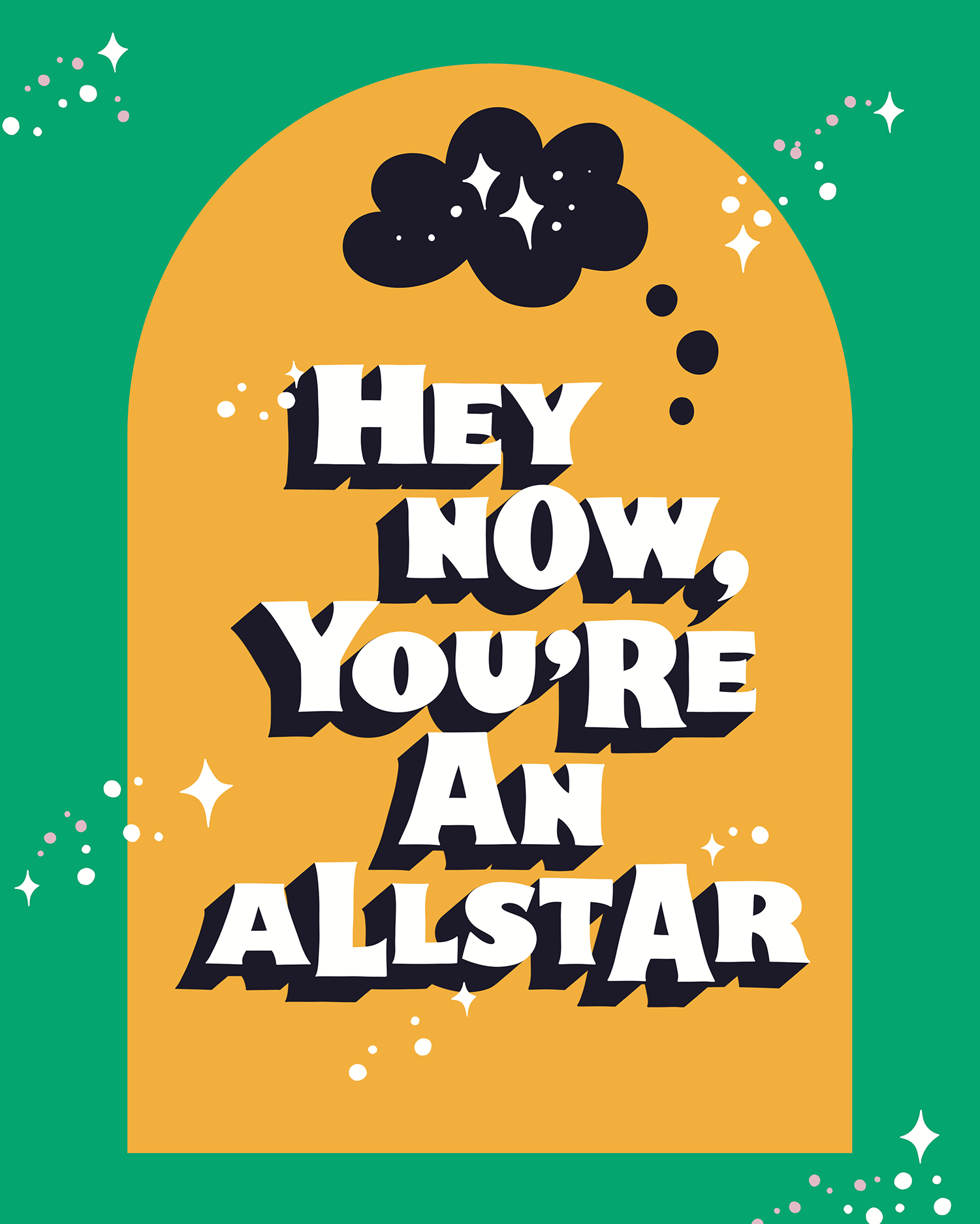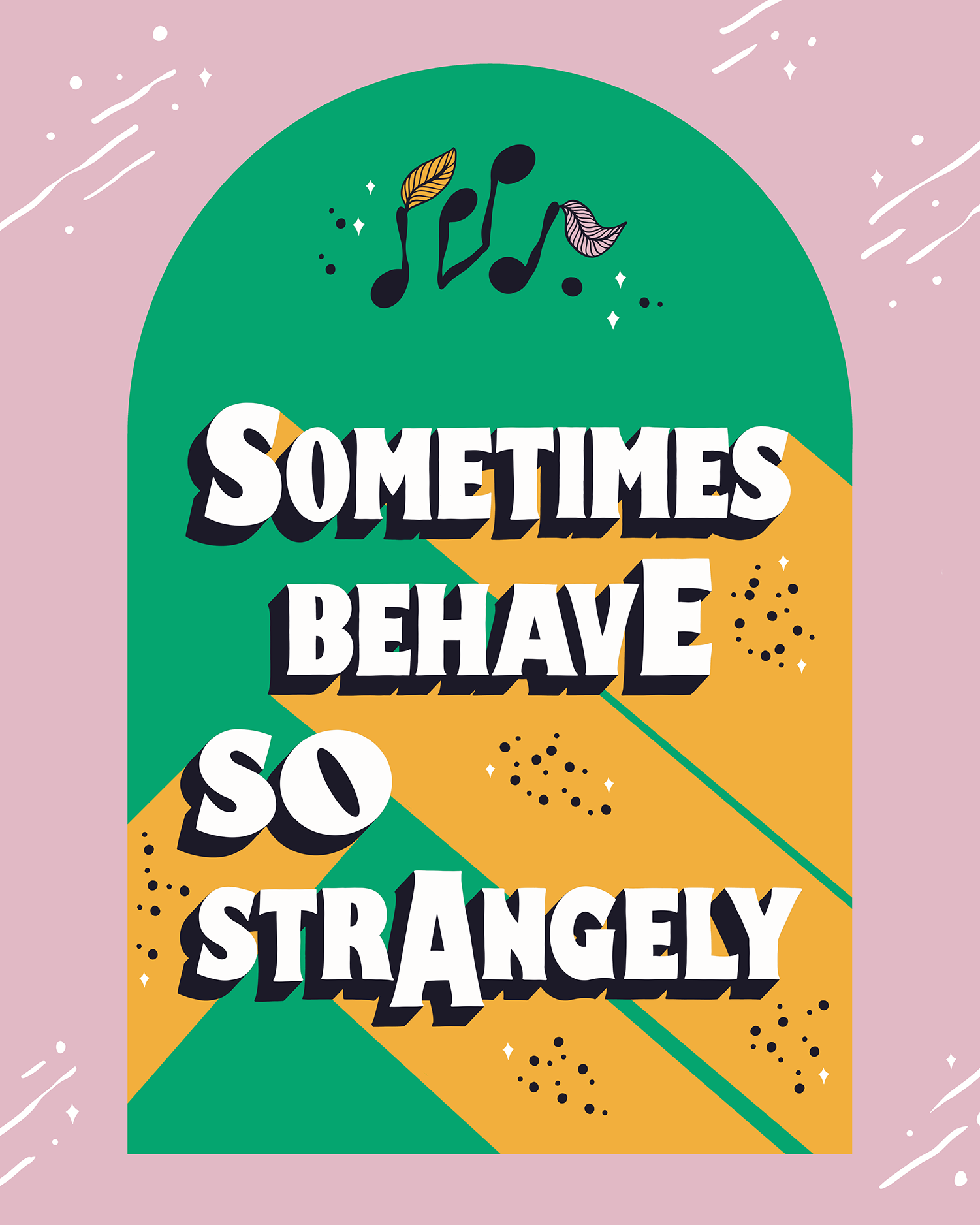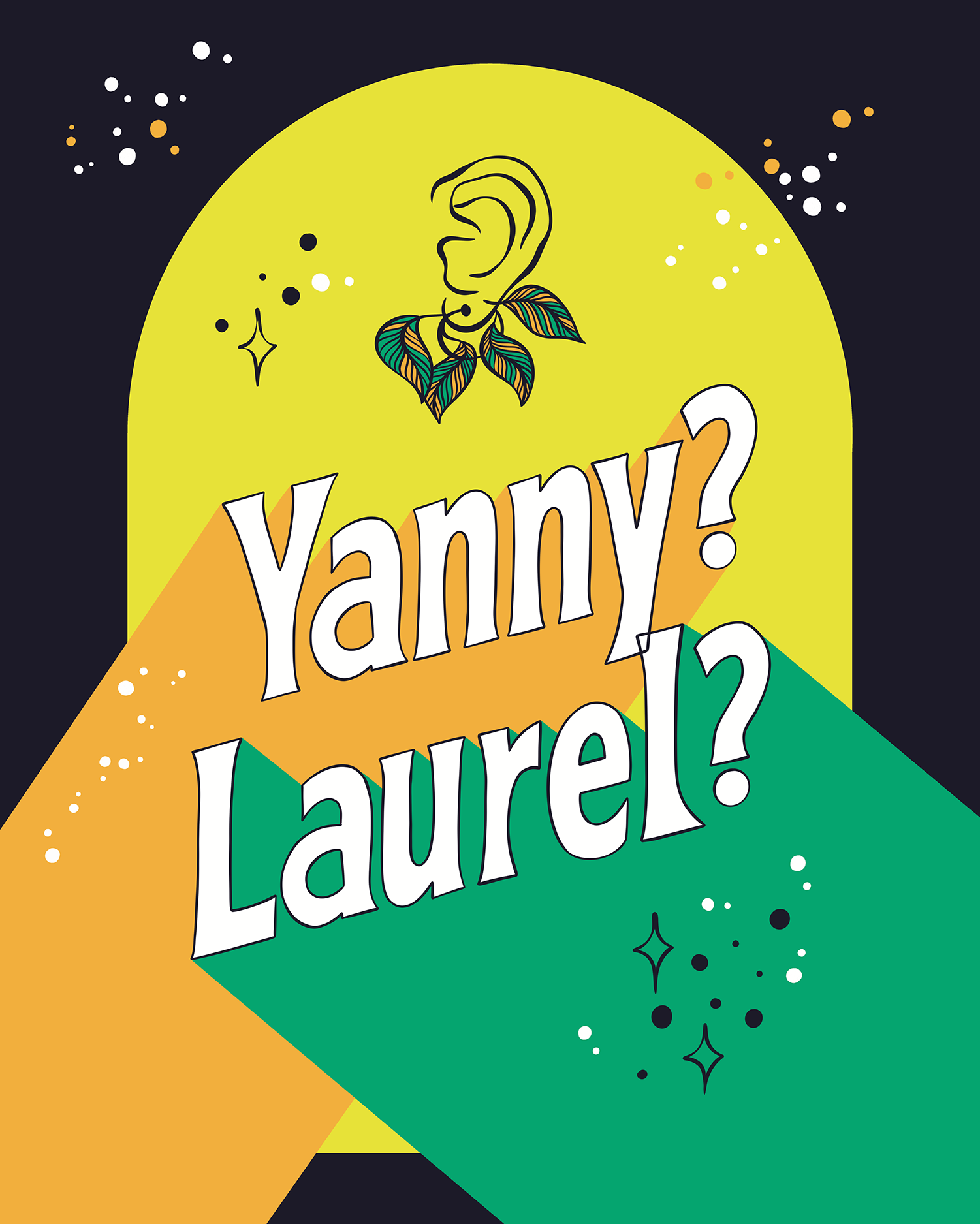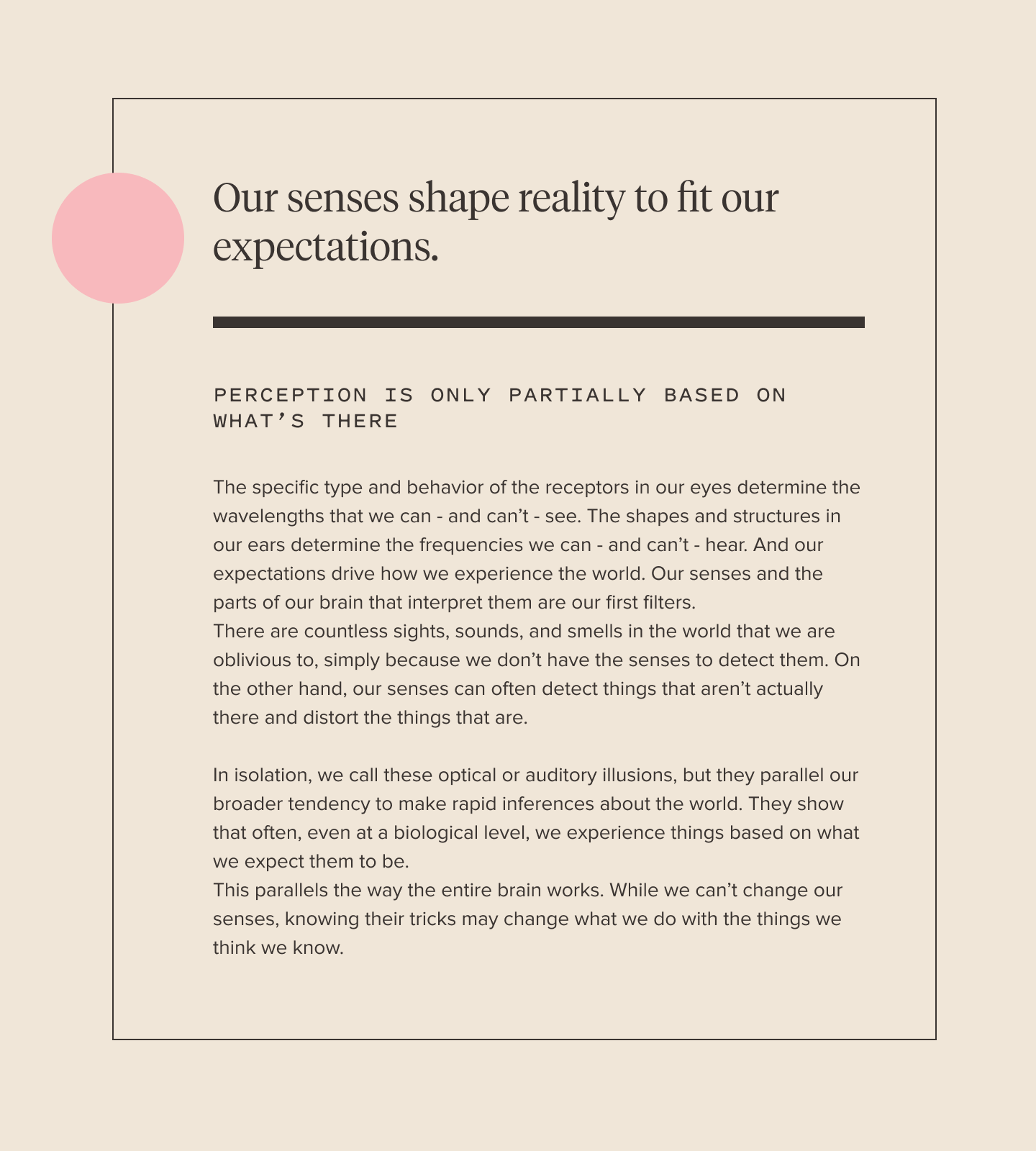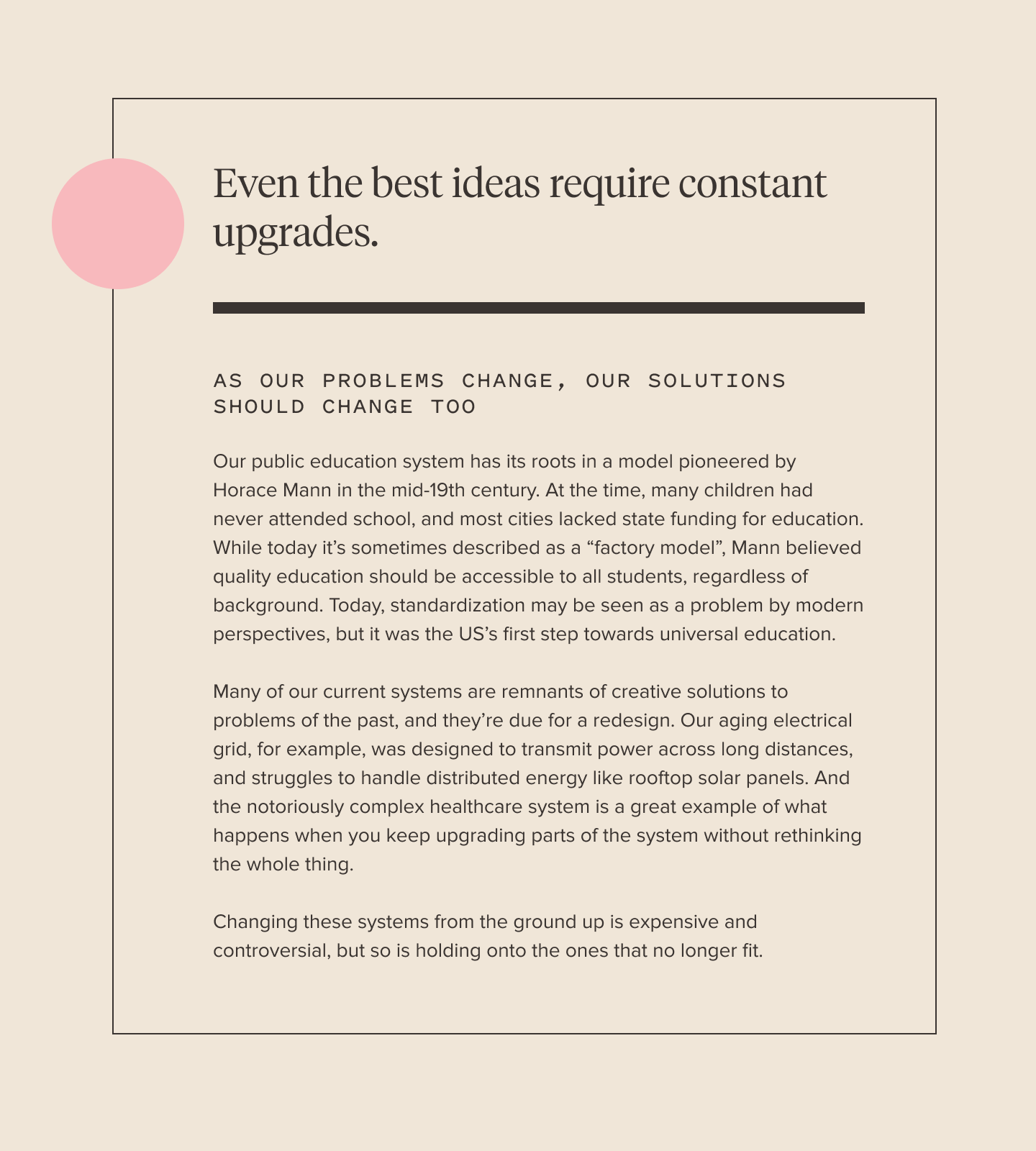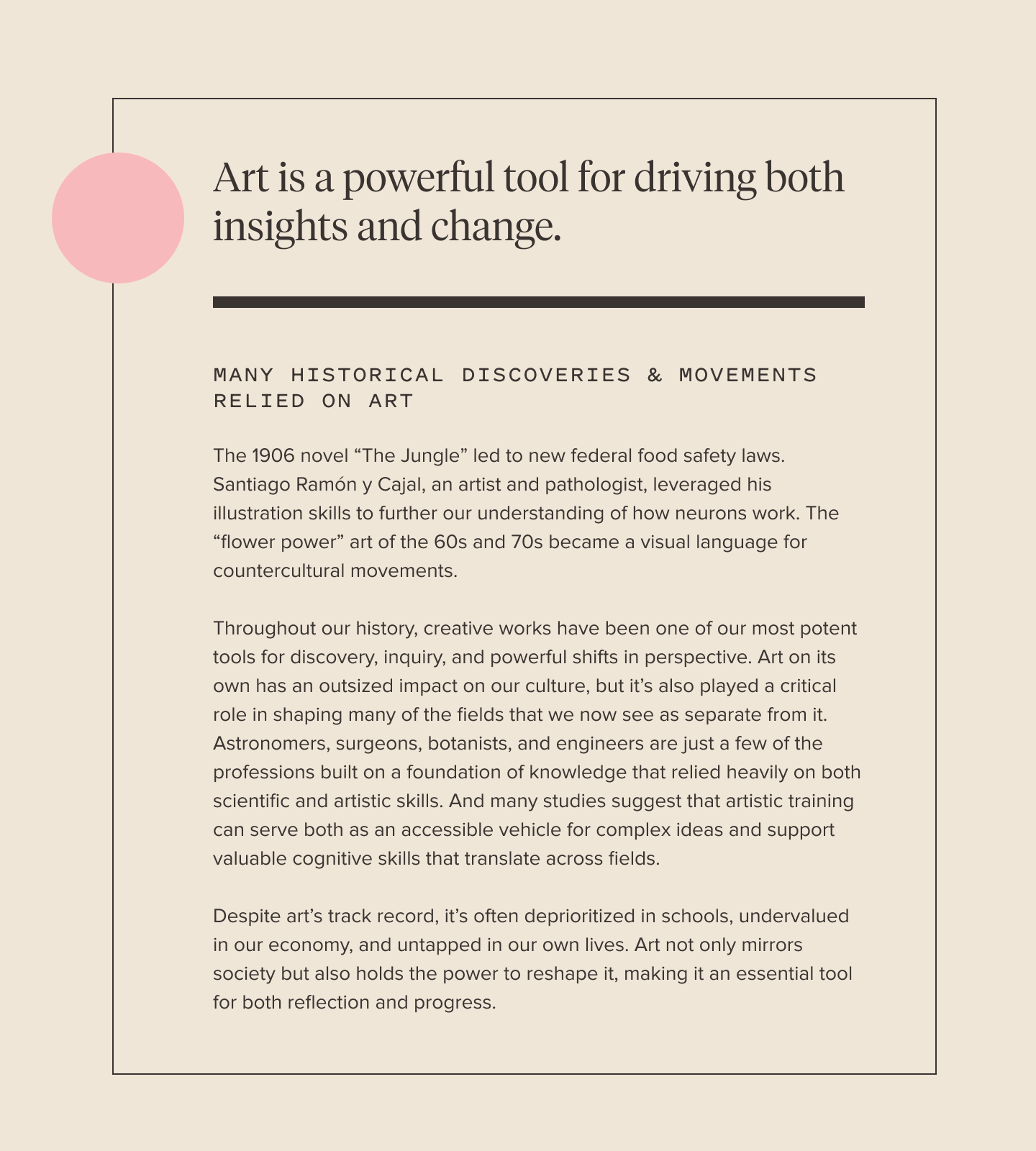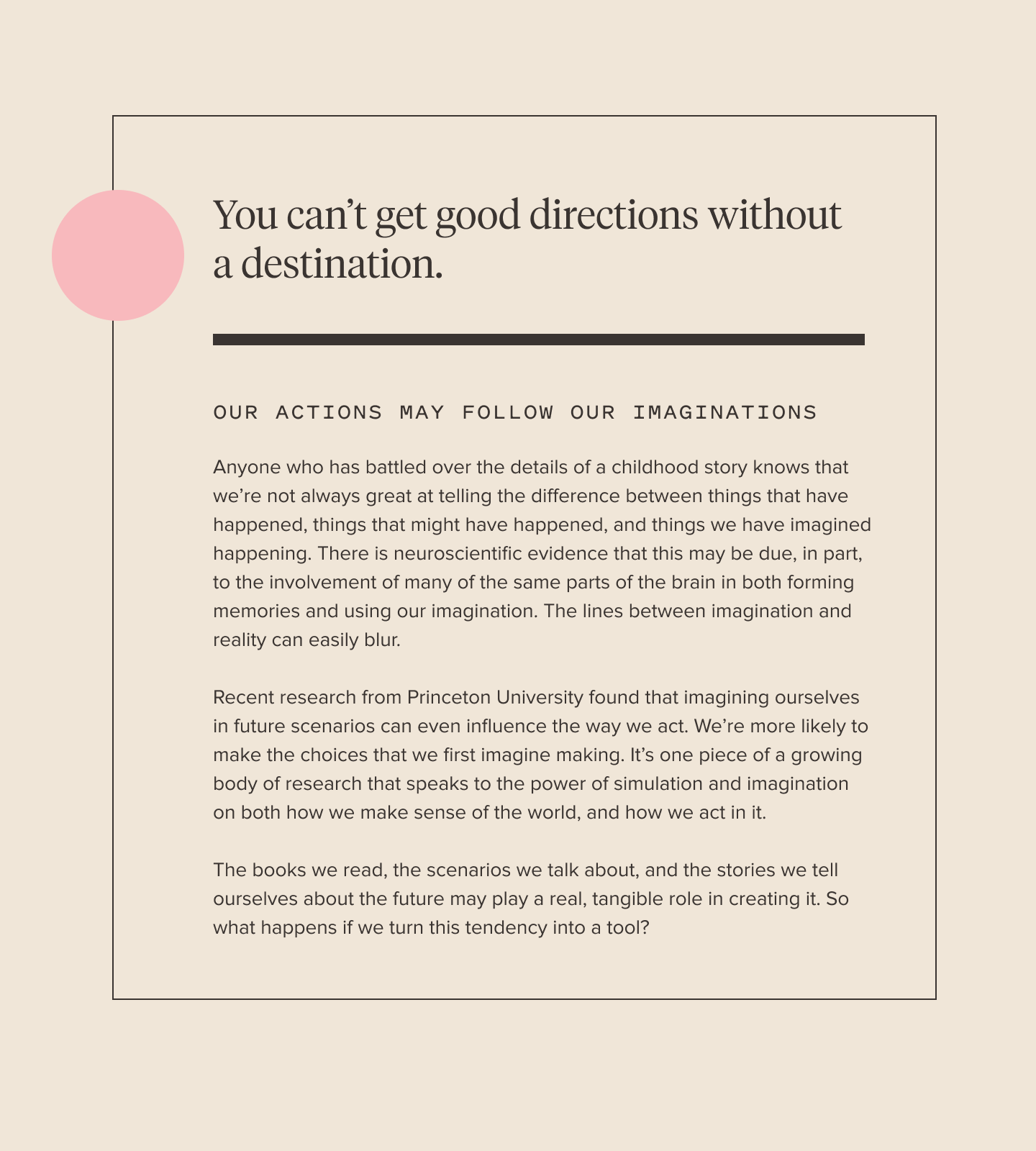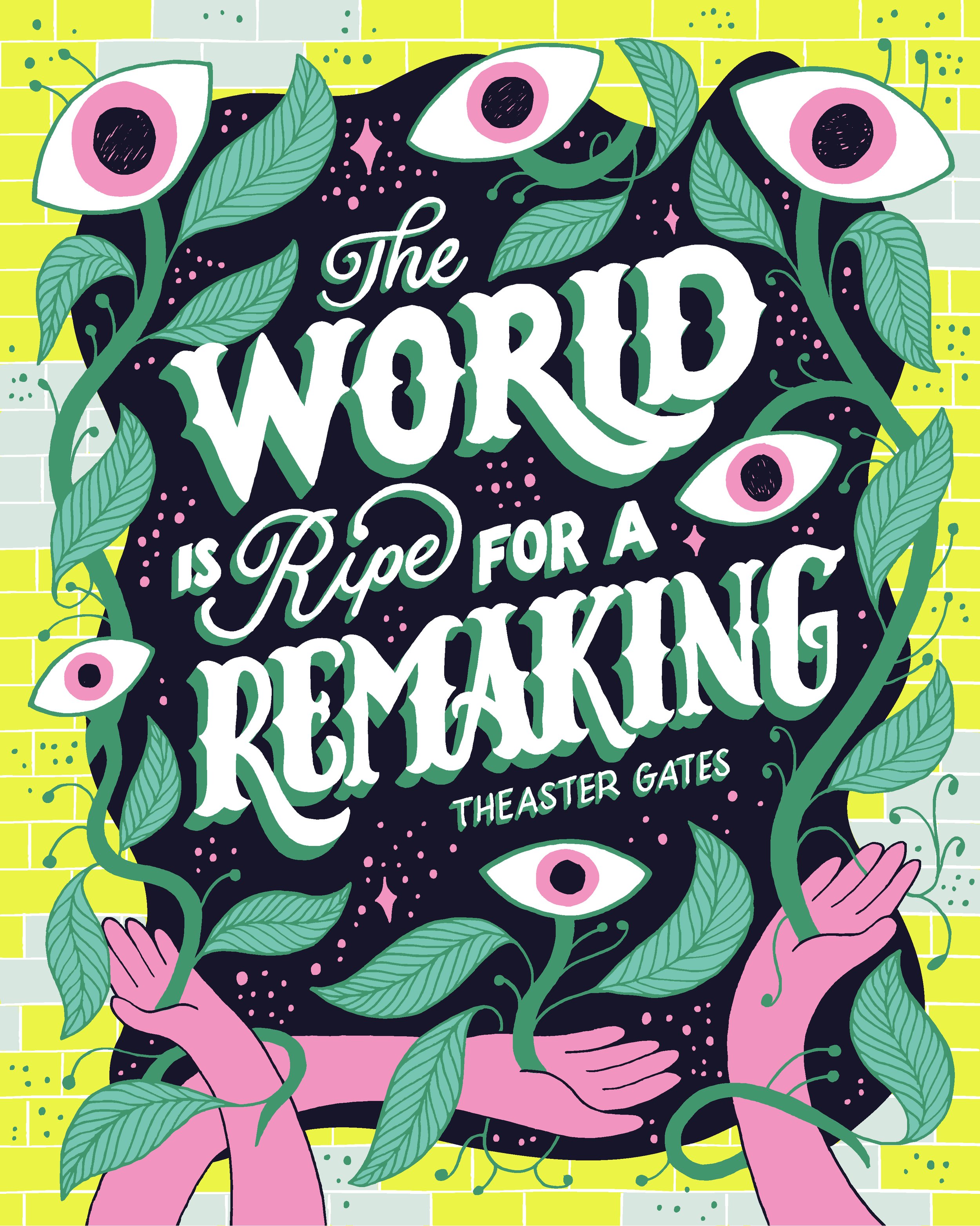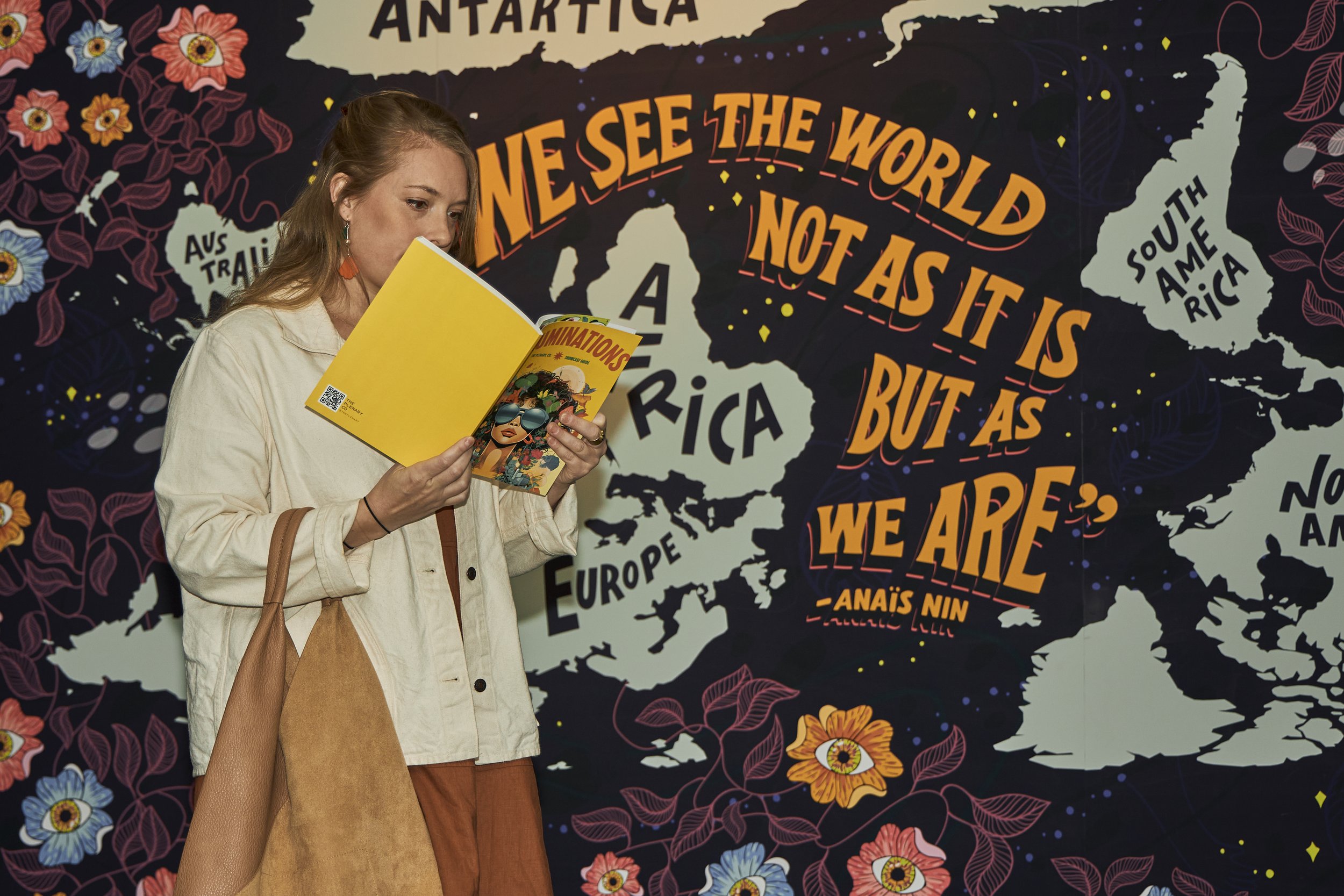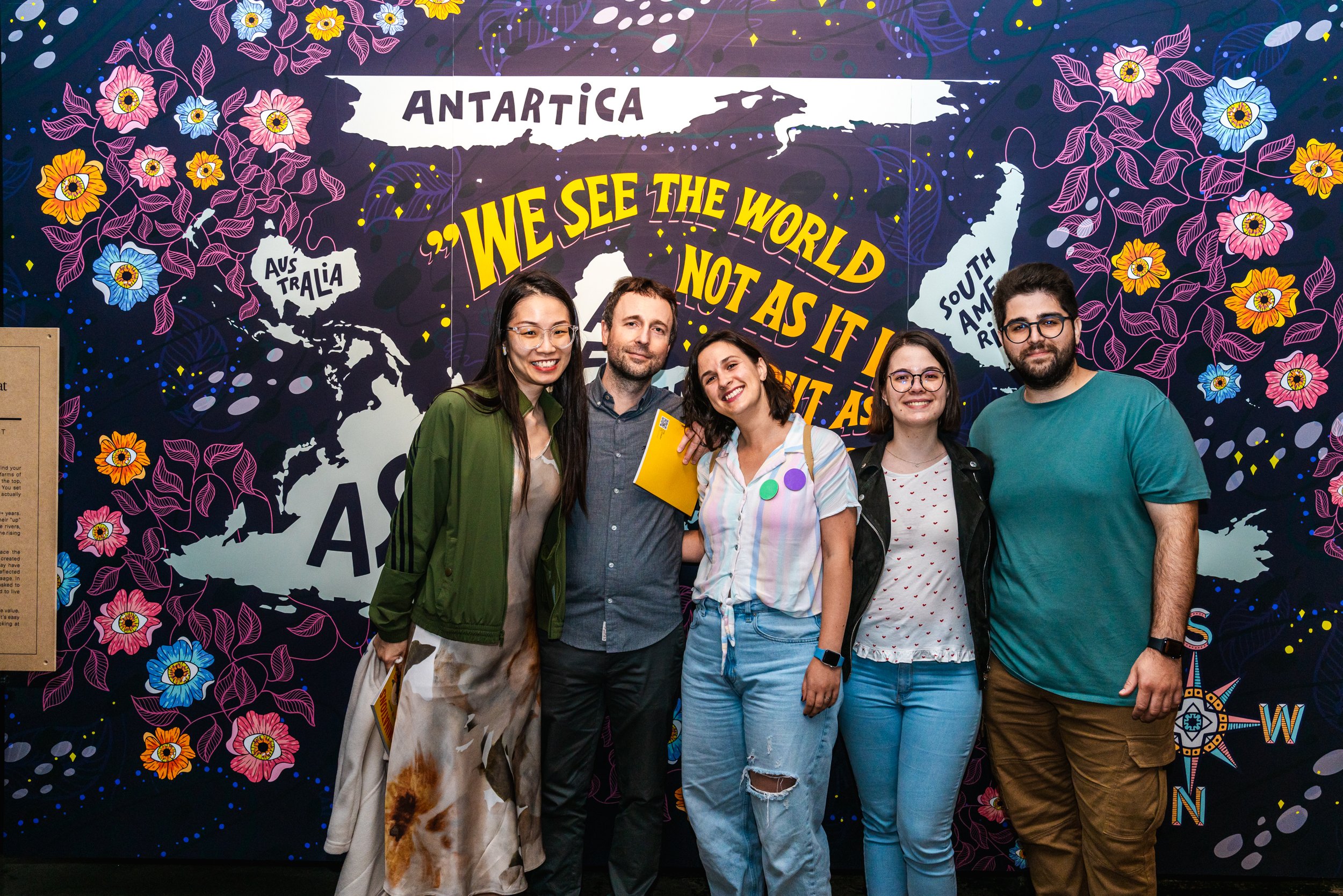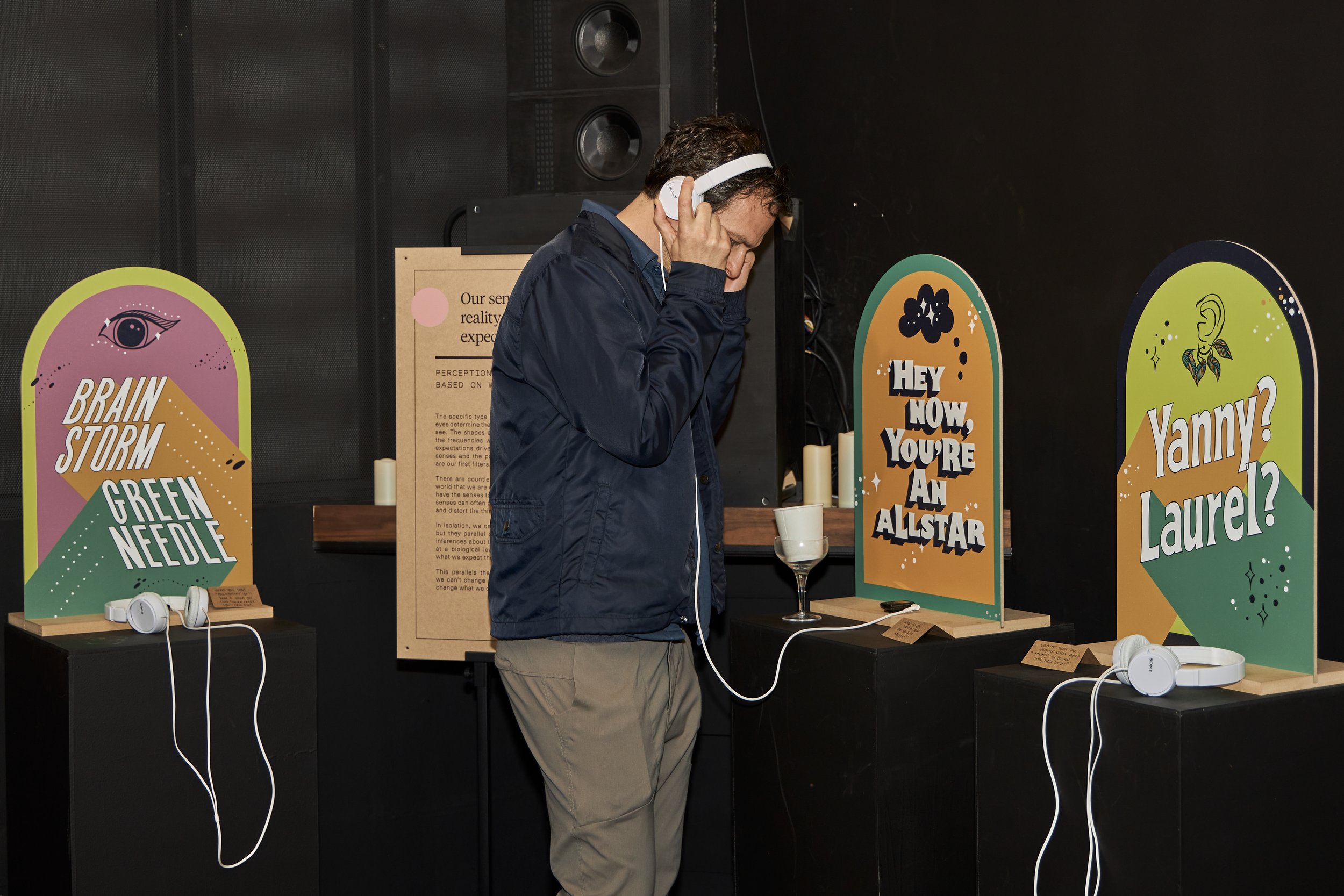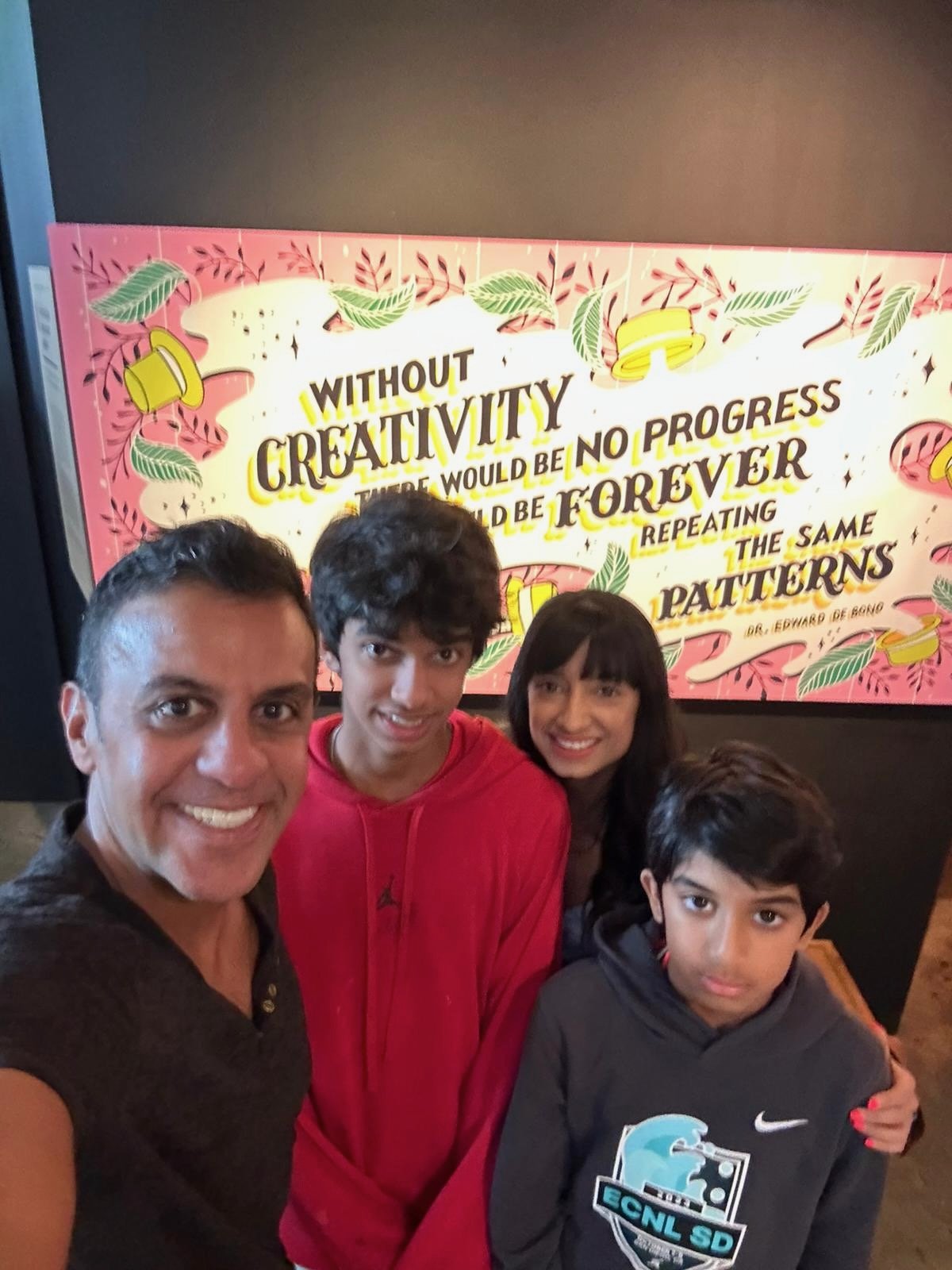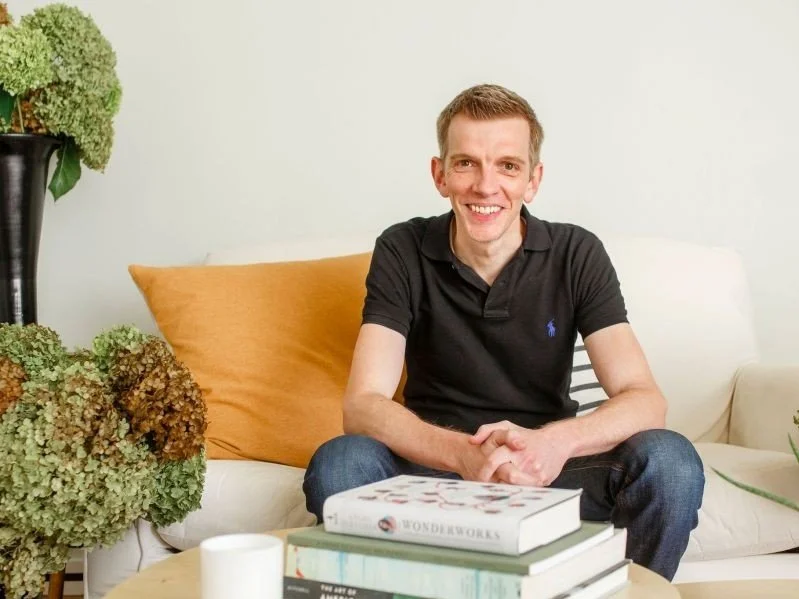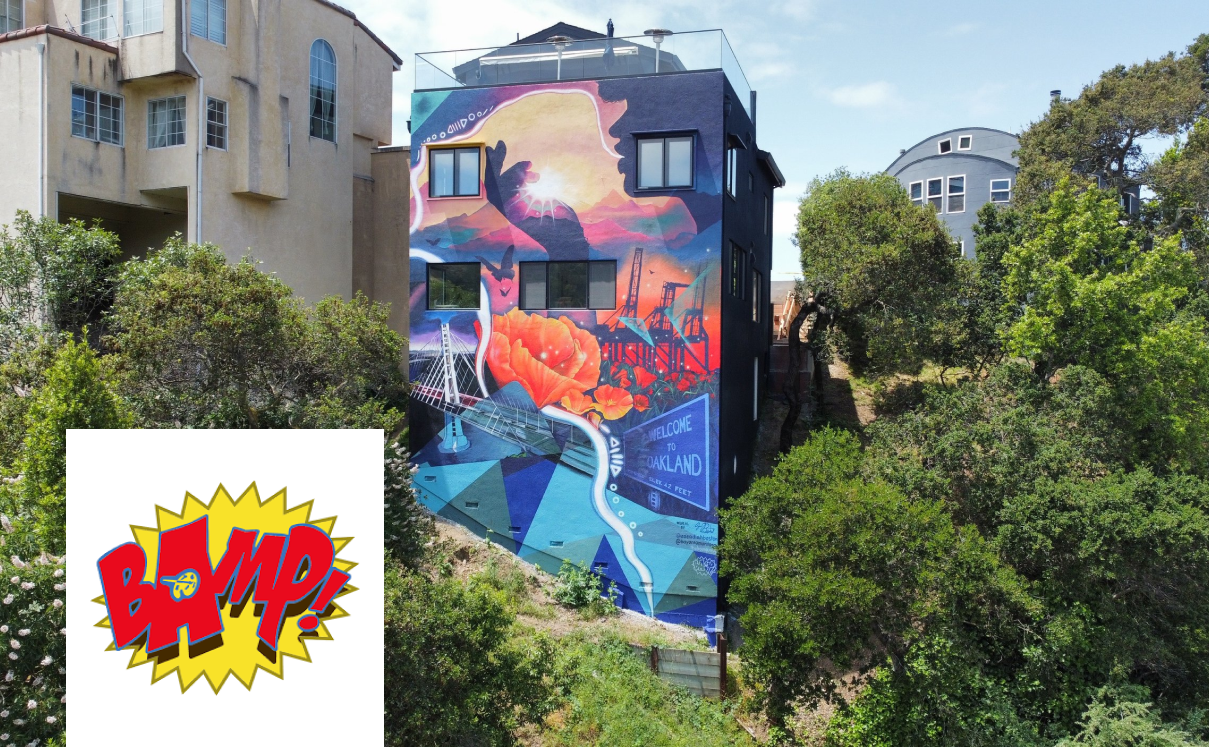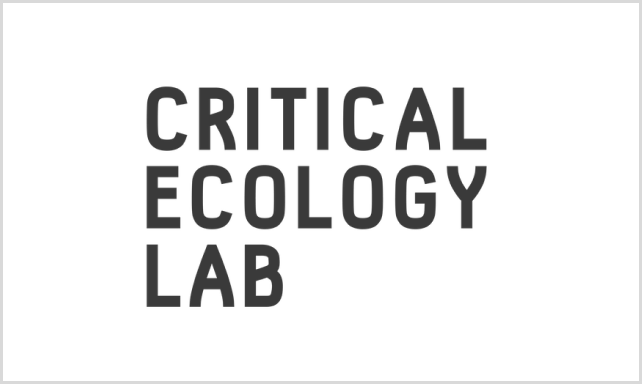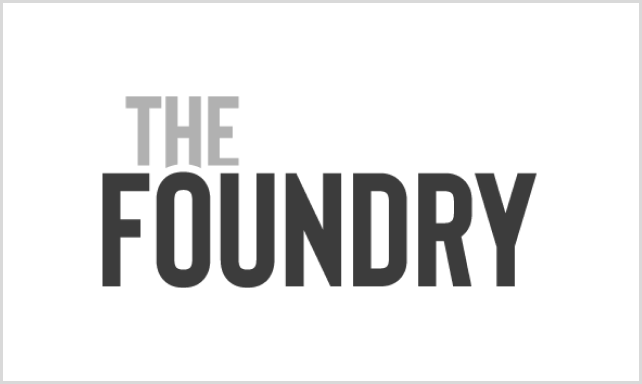BROUGHT TO YOU BY:IMAGINE THAT
LEAD ARTIST:
AFTRI MARRISKA
@AFTRISLETTER
So much of what surrounds us was once imagined, and we can reimagine it.
When our team was deciding which topics to explore, a few felt obvious, like AI, sustainability, and misinformation. Most people would agree that these are challenges we can't ignore.
So with limited time and a world of pressing issues, why did we decide to kick off with imagination? Many researchers believe that imagination has been a driving force in our evolution. It lets us anticipate scenarios without living them, visualize new tools and solutions, and supports community cohesion by seeing things from other perspectives. It’s one of our most powerful problem-solving skills, yet we rarely put it first when solving problems.
In school, we practice math drills and memorize historical facts, but little time is dedicated to cultivating our ability to imagine. We don’t practice looking for connections in unexpected places, protecting space for original thought, or untethering our solutions from the status quo. We test for analytical abilities and acquired knowledge, rather than the creative or imaginative capacities we need to solve the complex problems around us.
There’s no doubt that in our culture, leading with imagination can feel vulnerable. It can lead to experiments that don’t work or ideas that others reject. So instead, we lean into the skills that society taught us to practice and value – analysis, discipline, testing, certainty – leaving a lot of what’s possible hidden by what we're used to.
In a time when we’re often motivated by fear of what could go wrong, we hope this space will inspire you to explore the possibilities for what we could build.
We put imagination first, because everything else depends on it.
QUICK VIEW
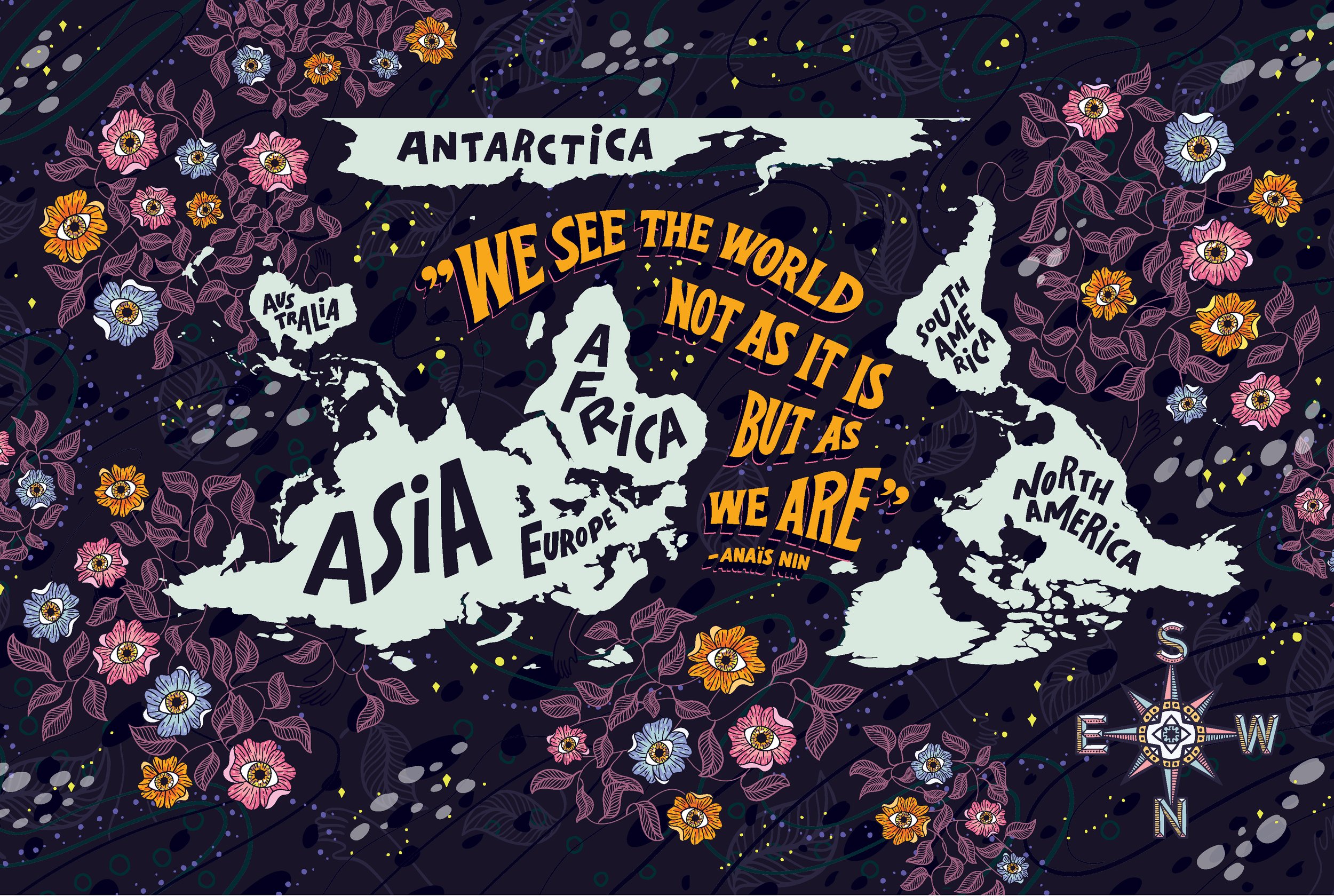
Which way is up? It depends on what you care about.
SOMETIMES REALITY IS JUST A MATTER OF PERSPECTIVE
It's 5000 BC, and you've been given a map to find your way from the dry lands of Cairo to the fertile farms of Upper Egypt. The map shows the Nile River at the top, flowing down towards the Mediterranean Sea. You set off in its direction, soon realizing that “up” is actually South.
We've relied on maps to find our way for 14,000+ years. In that time, different cultures have imagined their "up" based on things that they value: the flow of the rivers, their most sacred city, the regions they visit, or the rising of the sun.
The most common maps in the US today place the northern hemisphere at the top, based on a map created by a Flemish cartographer in the 1500s. He may have made the decision randomly, or it may have reflected what he most valued. Either way, it sends a message. In a 2011 study, for example, when people were asked to look at a make-believe map, they usually wanted to live near the "top".
The things we create are shaped by the things we value. But when those creations become our "default", it's easy to forget that it was always just one way of looking at things.
TRIVIA
So far as we know, there isn't much of an "up" or "down" in space, yet to accommodate our expectations, NASA has even been known to do what?
Orient images of earth from space so north is at the top.
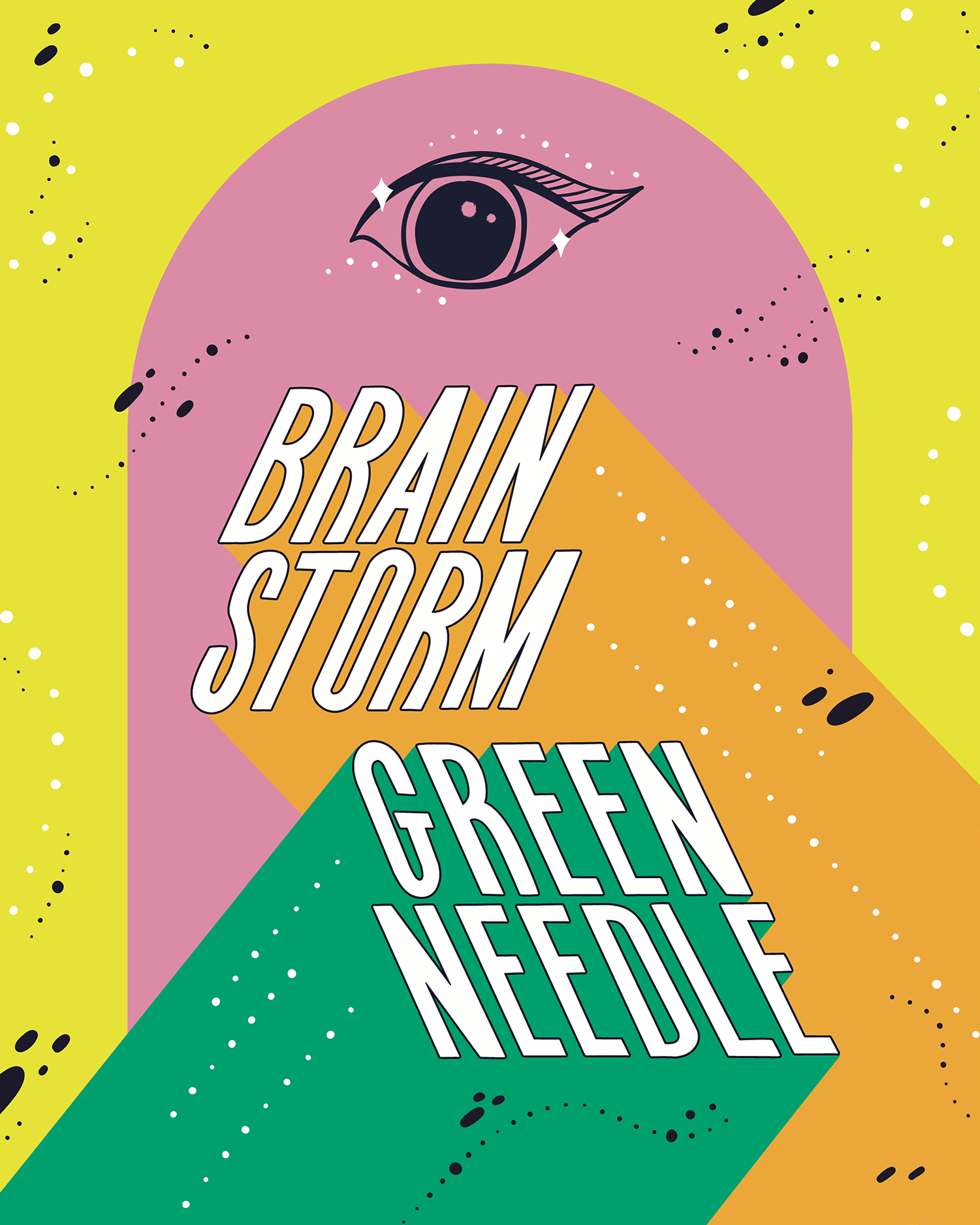

Our senses shape reality to fit our expectations.
PERCEPTION IS ONLY PARTIALLY BASED ON WHAT’S THERE
The specific type and behavior of the receptors in our eyes determine the wavelengths that we can - and can’t - see. The shapes and structures in our ears determine the frequencies we can - and can’t - hear. And our expectations drive how we experience the world. Our senses and the parts of our brain that interpret them are our first filters.
There are countless sights, sounds, and smells in the world that we are oblivious to, simply because we don’t have the senses to detect them. On the other hand, our senses can often detect things that aren’t actually there and distort the things that are.
In isolation, we call these optical or auditory illusions, but they parallel our broader tendency to make rapid inferences about the world. They show that often, even at a biological level, we experience things based on what we expect them to be.
This parallels the way the entire brain works. While we can’t change our senses, knowing their tricks may change what we do with the things we think we know.
Tricked by the Ear
Audio illusions are a great way to notice how our brains can automatically filter reality.
Listen closely to each of these audio illusions to test your ability to hear words and melodies that aren’t really there, or see how you interpret them differently than those around you.
Can we really believe what we hear? What else might our brains be distorting?
“Sometimes behave so strangely” begins to sound musical the longer you listen.the word you hear seems to depend on which phrase you are thinking about as you listen.THERE ARE NO LYRICS, JUST THE PIANO - BUT DO YOU STILL HEAR THEM?you will hear either "yanny" or "laurel" based on which frequency you hear.REFLECT
Making music is a universal human trait that goes back to at least 35,000 years ago. Music was often used to communicate over long distances, and define rituals. What was a time that music was able to capture or communicate something that nothing else could?
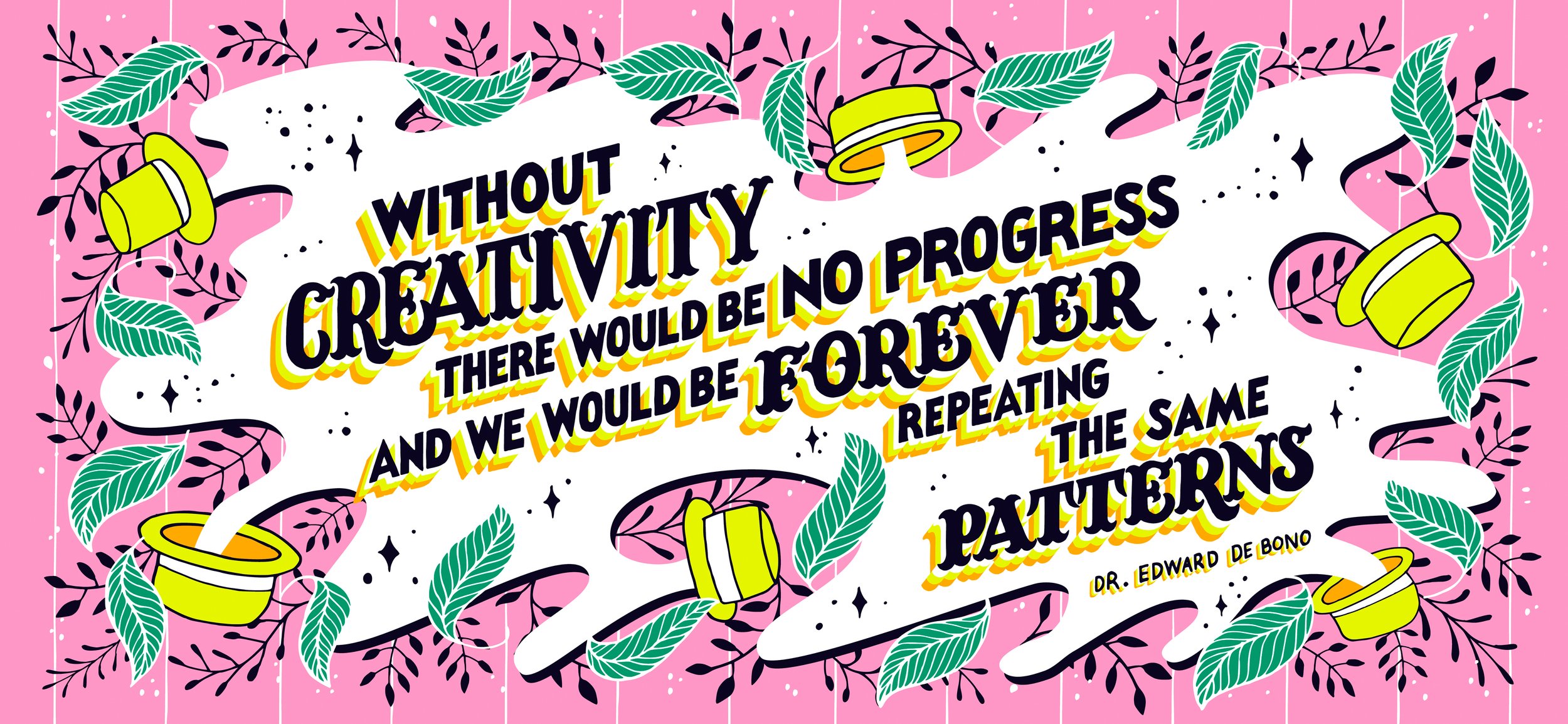
Even the best ideas require constant upgrades.
AS OUR PROBLEMS CHANGE, OUR SOLUTIONS SHOULD CHANGE TOO
Our public education system has its roots in a model pioneered by Horace Mann in the mid-19th century. At the time, many children had never attended school, and most cities lacked state funding for education. While today it’s sometimes described as a “factory model”, Mann believed quality education should be accessible to all students, regardless of background. Today, standardization may be seen as a problem by modern perspectives, but it was the US’s first step towards universal education.
Many of our current systems are remnants of creative solutions to problems of the past, and they’re due for a redesign. Our aging electrical grid, for example, was designed to transmit power across long distances, and struggles to handle distributed energy like rooftop solar panels. And the notoriously complex healthcare system is a great example of what happens when you keep upgrading parts of the system without rethinking the whole thing.
Changing these systems from the ground up is expensive and controversial, but so is holding onto the ones that no longer fit.
REFLECT
In what ways can individuals and communities contribute to the evolution and adaptation of systems to better address current challenges?
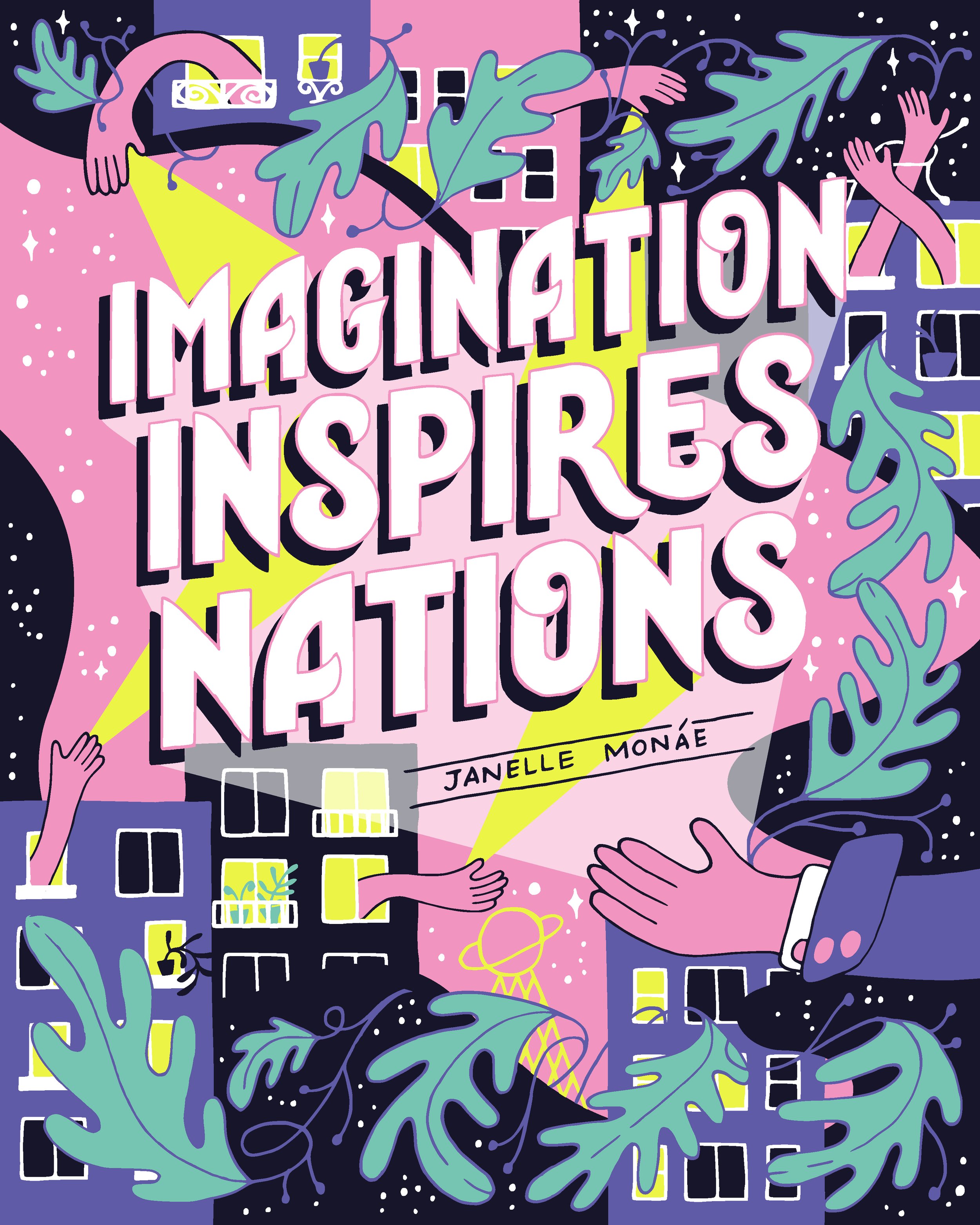
Art is a powerful tool for driving both insights and change.
MANY HISTORICAL DISCOVERIES & MOVEMENTS RELIED ON ART
The 1906 novel “The Jungle” led to new federal food safety laws. Santiago Ramón y Cajal, an artist and pathologist, leveraged his illustration skills to further our understanding of how neurons work. The “flower power” art of the 60s and 70s became a visual language for countercultural movements.
Throughout our history, creative works have been one of our most potent tools for discovery, inquiry, and powerful shifts in perspective. Art on its own has an outsized impact on our culture, but it’s also played a critical role in shaping many of the fields that we now see as separate from it. Astronomers, surgeons, botanists, and engineers are just a few of the professions built on a foundation of knowledge that relied heavily on both scientific and artistic skills. And many studies suggest that artistic training can serve both as an accessible vehicle for complex ideas and support valuable cognitive skills that translate across fields.
Despite art’s track record, it’s often deprioritized in schools, undervalued in our economy, and untapped in our own lives. Art not only mirrors society but also holds the power to reshape it, making it an essential tool for both reflection and progress.
REFLECT
Our current school system still looks a lot like the one built for the end of the 19th century. If you think back to when you were a kid, what you enjoyed, and what you wish you knew as an adult, what subjects would you want prioritized? And what out-of-the-box ways could students learn about them?


You can’t get good directions without a destination.
OUR ACTIONS MAY FOLLOW OUR IMAGINATIONS
Anyone who has battled over the details of a childhood story knows that we’re not always great at telling the difference between things that have happened, things that might have happened, and things we have imagined happening. There is neuroscientific evidence that this may be due, in part, to the involvement of many of the same parts of the brain in both forming memories and using our imagination. The lines between imagination and reality can easily blur.
Recent research from Princeton University found that imagining ourselves in future scenarios can even influence the way we act. We’re more likely to make the choices that we first imagine making. It’s one piece of a growing body of research that speaks to the power of simulation and imagination on both how we make sense of the world, and how we act in it.
The books we read, the scenarios we talk about, and the stories we tell ourselves about the future may play a real, tangible role in creating it. So what happens if we turn this tendency into a tool?
TRIVIA
Engaging in creative activities can boost levels of this neurotransmitter, often termed the "feel-good" chemical. What is it?
Dopamine.

Take a moment.
Making time for even the simplest exercises can give us an opportunity to build our imaginative skills. People often think of creativity as a moment or spark, but it’s much more often a practice of patience, trial-and-error, and hard work. But practice makes perfect.
Look at the design below and create it in your journal. In the first box, turn it into the first thing that comes to mind. In the second, wait a few minutes. Think for a few minutes. Before you draw anything, let your mind wander, brainstorm associations, slow down, and give your mind a chance to imagine.
BRING HOME THE EXHIBIT
SIGNATURE SCENT
Mint, Mandarin, Bergamot, White TeaWe partnered with Casita Michi to create custom, limited edition candles inspired by the themes of each exhibit.
SIGNATURE COCKTAIL
BAR HILL GIN, HONEY, LEMON, GINGER, PROSECCOThe baristas at The Foundry created custom cocktails (and mocktails) inspired by the themes of each exhibit. Incorporate their recipes into your home gatherings to get a taste of the exhibit.
MEDIA RESOURCES
What to check out next.
WORD BANK
“Our media and political landscape continue to be siloed into ‘creatives’ and ‘scientists’, which isn’t helpful for creating social or environmental change.”
— hana ayoob
science communicator & illustrator
“imagine that” contributor

SCIENCE SPOTLIGHT
Stories influence our memories, and the ways we imagine the future.
Maybe your uncle has his old fishing stories on repeat. Or your grandmother loves to recount the day she met your grandpa. But why do the details seem to change each time they tell them?
When we really stop to think about it, our memories are a lot less reliable than we’d like them to be. Even memories that are considered “flashbulb” memories – those proposed in 1977 by psychologists Roger Brown, PhD, and James Kulik, PhD, as memories so emotionally important to us that they’re recounted as vividly, completely and accurately as a photograph[1] – are faulty. Studies show that “flashbulb” memories are actually reshaped every time we tell them. For example, many people claim to remember exactly where they were and what they were doing on 9/11, but data show they’re often mixed up with inaccuracies and filtered by other happenings in our life[2].
It turns out that the stories told by the media about events like 9/11, or stories about your own childhood told by your relatives, engage a part of the brain that processes memories[3]. When we go to recount those memories, we feel confident that they’re accurate and that we actually lived them, when really they could be based solely on a story someone told us. This is why eye-witness accounts can be unconsciously corrupted by leading questions and conversations with other witnesses.
And while we think our memories only affect how we see our past, a 2012 review paper summarized work that suggests ways that memory may also play a role in our imagination and future thinking[4].
In multiple studies, many of the same brain regions, as shown by fMRI brain scans, are active when people engage their memory as when they imagine future situations. A network that involves a region called the “hippocampus” is related to both of these mental exercises. Additionally, other research shows that patients with amnesia who suffered damage to their hippocampus, had challenges with both memory and learning, and imagining the future.
So, why is that important?
If memory can be manipulated by external stories and the act of remembering is entangled with that act of imagination, there may be a connection between the stories we put out into the world and the ways that we do – and don’t – imagine the possibilities for the future. It may seem intuitive, but know how deep the connections are between memory, imagination, learning, and storytelling, what stories should we create to help us better imagine the future we want?
[1] Brown R, Kulik J. Flashbulb memories. Cognition. 1977;5:73–79.
[2] Hirst W, Phelps EA, Meksin R, et al. A ten-year follow-up of a study of memory for the attack of September 11, 2001: Flashbulb memories and memories for flashbulb events. Journal of Experimental Psychology. 2015;144(3):604–623. doi:10.1037/xge0000055
[3] Cohn-Sheehy, Brendan I., et al. "The hippocampus constructs narrative memories across distant events." Current Biology 31.22 (2021): 4935-4945.
[4] Schacter, Daniel L., et al. "The future of memory: remembering, imagining, and the brain." Neuron 76.4 (2012): 677-694.
FIELD SPOTLIGHTS
There are many leaders at the intersection of imagination and impact. Here are a few of the folks who inspire us across fields.
Follow the conversations
We’ve compiled lists of leaders in the space. While we can’t be responsible for what they say, we wanted to share a list of people that came up in our research.
Insider Insights
Takeaways that stuck with us from contributing experts.
REAL TALK
Ideas for action.
Organize a public art project.
Research shows that actively creating something helps us learn and connect. While it can feel like a daunting task to lead something new, several organizations exist with toolkits and resources to help you find a team, support, and market public art for impact. Check out Inside Out, a global art platform that helps communities around the world to stand up for what they believe in and spark global change locally.
SUPPORT THE NEXT GENERATION.
Culture building starts young. Support organizations that center imagination and creativity as tools not just for expression, but for solving problems. We recommend organizations like Chalk it Up! in Sacramento and Hip Hop for Change in the Bay Area.
CREATE A VISUALIZATION BOARD.
It’s like vision boarding, but using insights from the research to help shift your habits. Make a plan (preferably with pictures) imagining exactly how you’ll act in a situation you’ve been trying to change. Practice every detail in your mind, and keep coming back to it.
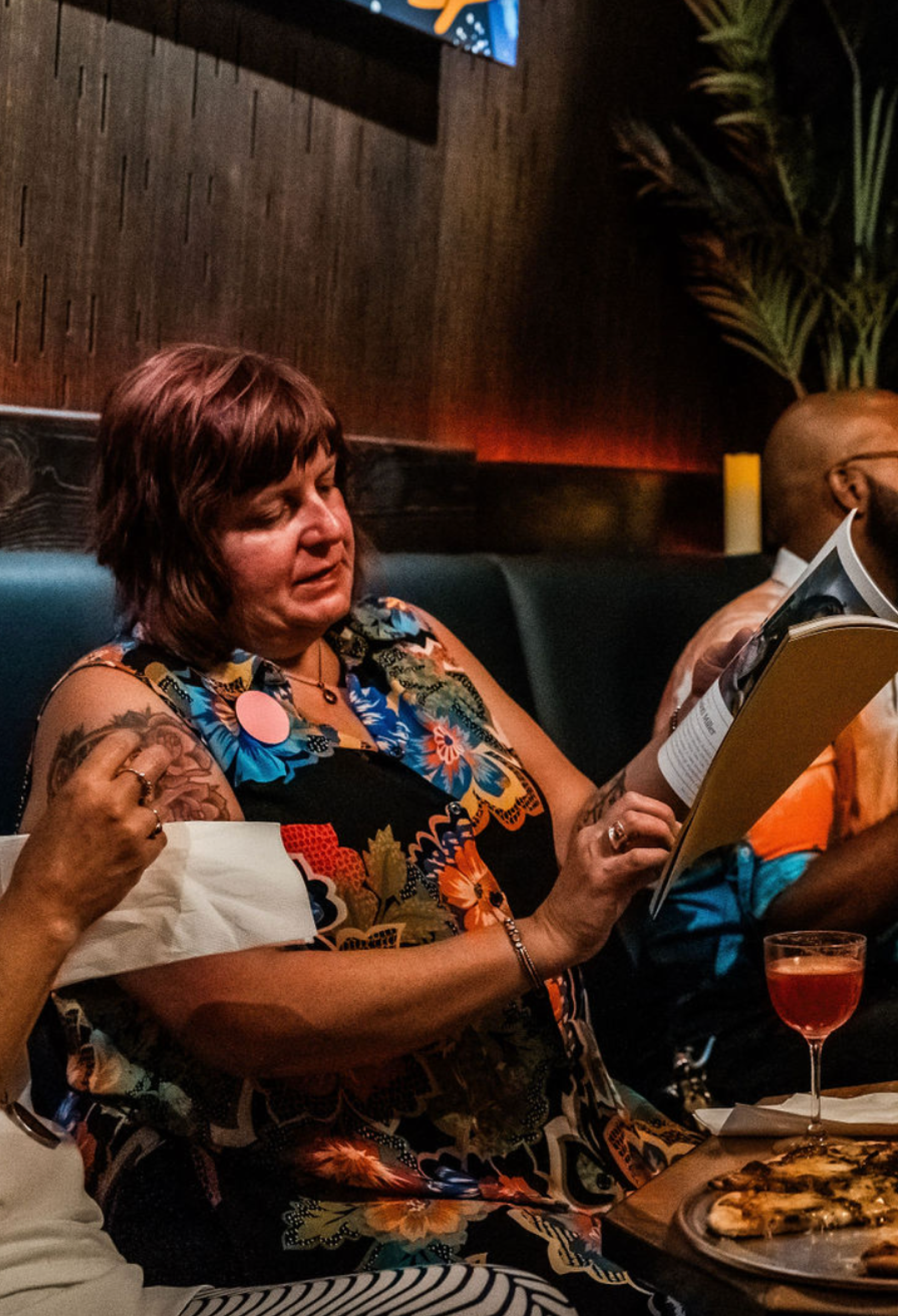
ORG SPOTLIGHTS

THE ARTIST
Aftri Marriska is an illustration and lettering artist from Pontianak, Indonesia, who creates playful and intricate designs for publication and murals. She infused the “Imagine That” exhibit with color and energy to bring an element of playfulness to the space, reminding participants that imagination is for grown-ups, too.
THANK YOU TO OUR CONTRIBUTORS
In addition to the countless authors and creators whose work we reviewed, we wanted to thank the experts who took the time to formally share their thoughts with us. While they’re not responsible for anything we got wrong, they may be responsible for a lot of what we got right!
Ashanti M. Davis, MA, Artist, Change & Community Experiences Designer, Pueblo
Crystal Dilworth, PhD, Neuroscientist & Science Communicator
Hana Ayoob, Science Communicator & Illustrator
Megan Erin Miller, Co-Founder, Practical by Design
Megan K. Halpern, PhD, Associate Professor, MSU
Melissa Pappas, Founder, Emerging Creatives of Science
Rachel Ropeik, Independent Educator & Facilitator
Rahul Bhargava, Assistant Professor, Northeastern University
Professor, University of Michigan (Anonymous)
Scientific Multimedia Producer (Anonymous)
Tinkering Specialist, Exploratorium (Anonymous)
ILLUMINATIONS WAS MADE POSSIBLE BY:COMMUNITY PARTNERS:SUSTAINING PATRONS:Andrew Watson
Camilla Rockefeller
David Kelley
Hillari & Michael Sasse
Wendi Zhang
CONTRIBUTORS:Astrid Countee, Research Associate
Camille Rose, Photographer
Crystal Dilworth, PhD, Board Member
Daniel Aguirre, Community Organizer
Esther Knox-Dekoning, Web Designer & Developer
Erick Salazar, Videographer + Photographer
Lindsay Newey, Animator
Kathleen Sheffer, Photographer
Maya Bialik, EdM, Board Member
Melissa Pappas, Arts & Exhibits Collaborator
Michelle Paull, Strategic Advisor
Sam Galison, Design Engineer
Samuel Knox, Software Developer
Stacey Baker, Research Associate
VOLUNTEERS:Alex Collins
Amanda Vera
Ana Ostrovsky
Andrew Graves
Bo Bradrich
David Kelley
Hillari Fine Sasse
Jimmy Maley
Kim Pedersen
Kim Tereco
Marques Jackson
Mauri Sanchez
Melissa Pappas
Michael Sasse
Negin Hemati
Pam Pedersen
Sandy Delgado
Spencer Kerber
Su Chon
Tracy Silver
Victoria Becker
Zoe Austin
THE PLENARY, CO. TEAM:Stephanie Fine-Sasse, Founder + Director
Ashley Cortés Hernández, Clubhouse Director
Christine La, Community Content Director
Samar Ibrahim, Community Engagement Manager

